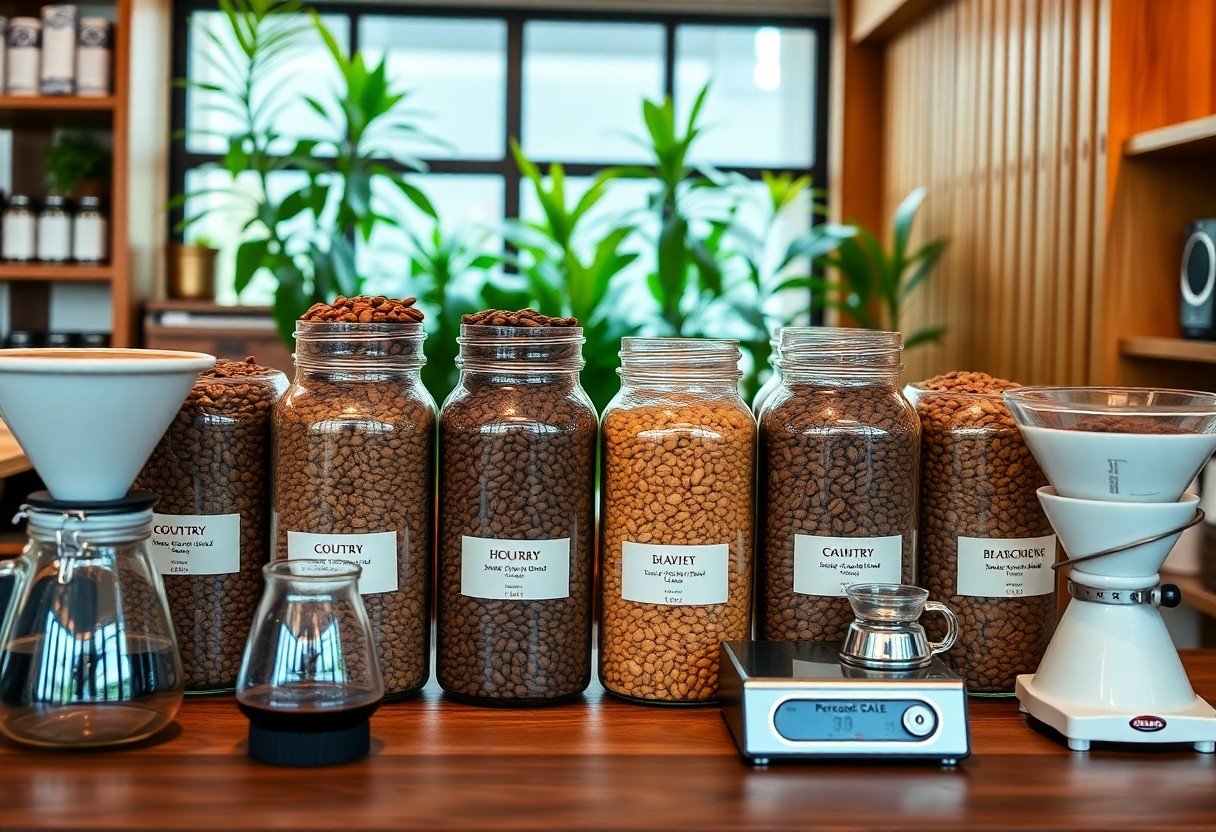Over the years, you may have noticed how the origin of your coffee affects its flavor profile. The unique characteristics of each coffee-growing region—including climate, soil, and processing methods—result in distinct tastes and aromas. By understanding the influence of origin, you can better appreciate the nuances of artisan coffee and make more informed choices about your brews. This post will guide you through the various roles that origin plays in defining coffee’s rich and complex flavors.

Unpacking Terroir: The Essence of Coffee Regions
Your coffee’s flavor is profoundly influenced by its terroir, the unique combination of environmental factors that shape its characteristics. Different regions bring distinctive qualities to the beans, driven by soil composition, altitude, and cultivation practices. For instance, beans from Ethiopia often exhibit floral and fruity notes due to the diverse ecosystems and rich, volcanic soil in which they grow. Conversely, Colombian coffees are known for their balanced acidity and nutty undertones, resulting from the varied highs and lows of mountainous terrains.
Geographical Influences on Flavor Development
Geography plays a vital role in flavor development, impacting everything from bean density to acidity. Regions with high altitudes typically yield denser coffee beans, enhancing acidity and resulting in a vibrant taste profile. For instance, beans grown in the highlands of Costa Rica often display significant brightness, while those from lower elevations may lean towards a smoother, milder flavor. Ultimately, your choice of coffee can directly reflect the geographical nuances of its origin.
Climate and Microclimates: More Than Just Weather
Climate and microclimates significantly affect coffee cultivation and flavor. Regions with consistent temperatures and specific humidity levels foster ideal growing conditions, allowing for optimum bean ripening. For example, the microclimates of Jamaica’s Blue Mountains provide consistent rainfall and cooler temperatures, leading to a mellow, complex cup. Understanding these climate influences helps you appreciate the deeper connections between your coffee’s origin and its flavor profile.
In addition to temperature and rainfall, microclimates shaped by topography can create localized weather variations that dictate coffee growth. For instance, the southern slopes of Mount Kilimanjaro benefit from increased sunlight while experiencing cooler nights, promoting slow maturation of coffee cherries and enhancing flavor complexity. Such environmental factors lead to the creation of beans that showcase enhanced sweetness, acidity, and overall flavor richness, which are distinctive to their specific microclimates. Your exploration of these unique growing conditions adds another layer of enjoyment to your coffee experience.
The Chemical Alchemy: How Origin Alters Flavor Compounds
Origin plays a pivotal role in determining the flavor compounds within your coffee, influenced by the interplay of climate, elevation, and cultivation practices. Specific environmental conditions shape the production of acids, sugars, and aromatic compounds, leading to distinct flavor profiles. For example, high-altitude coffees often present brighter acidity and fruity notes due to slower cherry maturation, while low-altitude counterparts may exhibit earthier, fuller flavors. Understanding this chemical alchemy allows you to appreciate the nuanced differences that origin imparts to your cup.
The Role of Soil Composition
Your coffee’s flavor begins in the soil, where mineral content, pH levels, and organic matter significantly impact growth and flavor development. Volcanic soils, rich in nutrients, often yield beans with complex, vibrant profiles, while sandy soils can lead to milder flavors. For instance, coffees grown in Ethiopia’s mineral-rich earth boast floral and citrusy notes, reflecting the interaction between the soil’s composition and the cherry’s characteristics.
Varietals and Their Unique Taste Profiles
Coffee varietals contribute unique tastes influenced by their genetic makeup and the conditions in which they are cultivated. Varietals such as Gesha, known for its floral and jasmine-like aroma, contrast sharply with the chocolatey and nutty notes of bourbon. Each varietal expresses distinct flavor nuances based on how it interacts with its environment, creating a diverse tasting experience. You may find that exploring these varietals opens up a deeper appreciation for the subtleties of coffee.
Varietals showcase not just differences in flavor, but also how specific adaptations have evolved based on their native regions. For example, the Caturra variety thrives in high-altitude areas of Colombia, leading to pronounced acidity and fruity undertones, while Typica, originating from the same region, offers a smoother and more balanced flavor. Understanding these nuances allows you to select coffees that resonate with your palate preferences and elevates your coffee experience, ensuring that every brew reflects the rich heritage and specificity of its origin.
Cultural Practices: The Artisan Touch in Coffee Production
Your coffee’s flavor is intricately shaped by the cultural practices that accompany its production. Artisan coffee producers often employ traditional methods passed down through generations, which infuse unique characteristics into the beans. These practices, encompassing everything from the choice of cultivation techniques to interactions within the local community, create a rich tapestry of flavors that cannot be replicated elsewhere. The emphasis on quality over quantity in artisan cultivation practices allows for a deeper exploration of nuanced flavors in every cup.
Traditional Farming Techniques and Their Impact
Utilizing shade-grown cultivation, many artisan coffee farmers preserve biodiversity and enhance flavor profiles in your coffee. This organic method entails growing coffee under canopies of trees, which not only protects the beans from harsh sunlight but also contributes to a more complex taste by promoting soil health and a balanced micro-ecosystem. Farmers often integrate heritage varieties, which further deepens flavor complexity, ensuring a distinct taste reflective of the region’s unique terroir.
Processing Methods: From Wet to Dry
Processing methods significantly influence coffee flavor, with each technique highlighting different flavor notes. Wet processing, or washed coffee, enhances brightness and acidity by removing the fruit before fermentation, resulting in cleaner flavors. In contrast, dry processing allows the cherry to ferment naturally around the bean, imparting fruity and robust characteristics. You’ll find that the choice between these methods can markedly affect the cup profile, showcasing the skill and intention of the artisan producer.
In wet processing, the cherries are harvested and then pulped to remove the outer skin, followed by fermentation. This process can take anywhere from 12 to 48 hours, depending on environmental conditions. The result is an enhance brightness, clarity, and acidity in your coffee, making it ideal for highlighting floral and citrus notes. Conversely, dry processing dries the whole cherries in the sun, allowing the sugars in the fruit to penetrate the bean, resulting in a heavier body with sweeter flavors. Each method offers a unique interpretation of the coffee, showcasing the artisan’s choice and skill in reflecting the origin’s distinct flavor palette.
The Roast Connection: Bridging Origin Flavors and Brewing Techniques
Your choice of roasting profile significantly impacts how the unique flavors from different origins are expressed in the cup. A lighter roast may enhance fruity acidity from Ethiopian beans, while a darker roast could bring out chocolatey undertones in Brazilian coffees. Each bean’s inherent characteristics come to life based on the roast’s intensity and duration, thus creating a bridge between the origin’s flavor and the final brew.
Roasting Profiles Tailored to Specific Origins
Specific origins benefit from tailored roasting profiles that accentuate their unique flavor notes. For instance, Guatemalan coffees, with their rich chocolate and caramel profiles, require a medium roast to balance sweetness and acidity, whereas Colombian beans shine under a medium-dark roast that brings forward their nutty and fruity nuances. Understanding the harmony between origin and roast helps craft an exceptional coffee experience.
Brewing Techniques That Highlight Origin Distinctions
Employing the right brewing techniques can further enhance the unique attributes of different coffee origins. For instance, a pour-over method can elevate the clarity and vibrant acidity found in Central American coffees, while a French press might be more suitable for highlighting the full-bodied richness of Indonesian beans. Both methods allow you to explore the intricacies that define each coffee’s unique flavor profile.
Utilizing specific brewing techniques tailored to origin specifications can elevate your coffee tasting experience. For example, the Chemex and V60 pour-over styles promote clarity, thus allowing the floral and citrus notes of East African coffees to shine. In contrast, immersion methods like the Aeropress or French press extract deeper flavors, making them ideal for coffees with robust body, such as those from Sumatra or the Amazon. By adjusting water temperature and grind size, you can fine-tune each brew to reflect the distinct characteristics originating from the bean’s terroir.

The Future of Artisan Coffee: Trends Shaping Flavor Preferences
The future of artisan coffee is set to be influenced by evolving consumer tastes and a greater focus on personalization. From medium-bodied blends to single-origin beans, your preferences are becoming more nuanced. Emerging coffee markets in countries like Ethiopia and Colombia are introducing diverse flavor profiles that expand your palate. The shift towards cooler brewing methods, such as cold brew and nitro coffee, showcases a growing interest in refreshing, vibrant flavors that cater to today’s coffee enthusiasts.
Sustainability and Its Influence on Origin Selection
Choosing coffee with sustainable practices is reshaping your connections to its origin. Producers who prioritize eco-friendly farming methods not only enhance biodiversity but also improve flavor quality through soil health. By selecting coffees labeled as organic or Fair Trade, you not only enjoy a better cup but also support communities invested in environmentally sustainable practices.
The Rising Importance of Transparency in Coffee Sourcing
Transparency in sourcing offers you deeper insights into where your coffee comes from and the conditions under which it is produced. This shift has led roasters to share detailed information about their supply chains, including the specific farms and farming practices involved. For instance, Direct Trade relationships allow you to connect with farmers directly, often resulting in higher quality beans and more equitable compensation for growers.
Expending on the significance of transparency, many roasters now provide QR codes on packaging, linking you to stories about the origin and processing of the beans. This not only enhances your appreciation of the flavors but also fosters a stronger connection to the growers and their communities. By understanding the journey of your coffee, you can make more informed choices that align with your values, knowing that your purchase supports ethical and sustainable practices in the coffee industry.
Final Words
With these considerations, you can appreciate how the origin of coffee beans significantly influences the flavor profiles of artisan coffee. Your understanding of geographic factors, climate conditions, and cultivation practices enables you to identify the unique characteristics in each cup. This knowledge not only enhances your tasting experience but also deepens your connection with the artisans who craft each blend. By exploring different origins, you can expand your palate and truly savor the diversity that artisan coffee has to offer.
FAQ
Q: How does the origin of coffee beans affect flavor profiles?
A: The geographical location where coffee beans are grown significantly influences their flavor. Factors such as soil composition, altitude, climate, and local processing methods contribute to unique taste characteristics, ranging from fruity and floral to nutty and chocolatey.
Q: What role does altitude play in shaping the flavor of artisan coffee?
A: Higher altitudes generally lead to slower coffee bean maturation, which can enhance acidity and complex flavors. Beans grown at elevations above 1,200 meters often exhibit brighter, more refined tastes, making them desirable for artisanal coffee.
Q: How do processing methods impact the flavor derived from coffee origins?
A: Processing methods, such as washed, natural, or honey processing, affect the final flavor profile of coffee. For instance, washed coffees tend to have cleaner flavors and higher acidity, while natural processed coffees can present a more vibrant fruitiness, influenced by the origin’s growing conditions.
Q: Can different regions produce similar flavor profiles?
A: Yes, different regions may produce coffees with similar flavor notes due to analogous climate and soil conditions. However, subtle distinctions often arise based on local farming practices and specific microclimates, making each origin unique.
Q: Why is it important for artisan coffee roasters to source beans from specific origins?
A: Artisan coffee roasters emphasize sourcing from specific origins to highlight distinctive flavor traits and support sustainable farming practices. This focus allows them to curate a diverse range of flavors, providing consumers with a more authentic and varied coffee-tasting experience.

